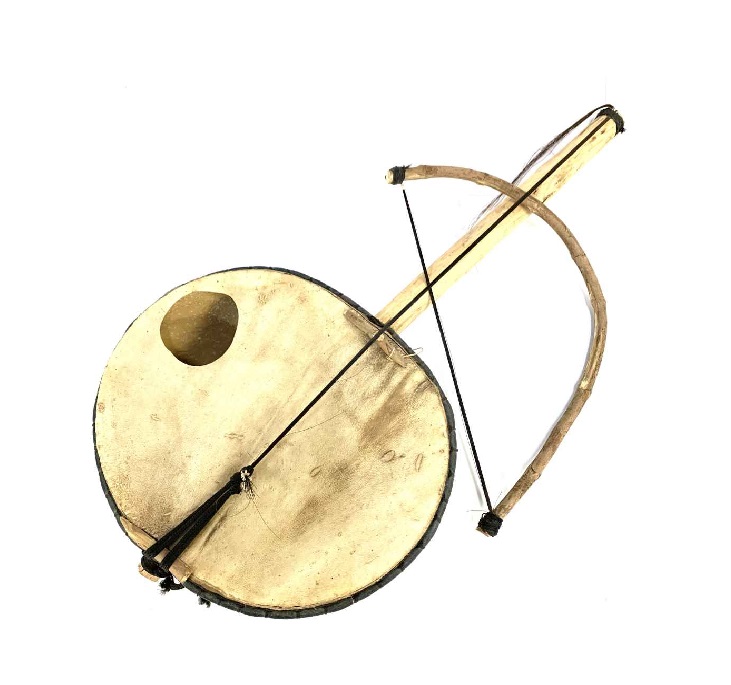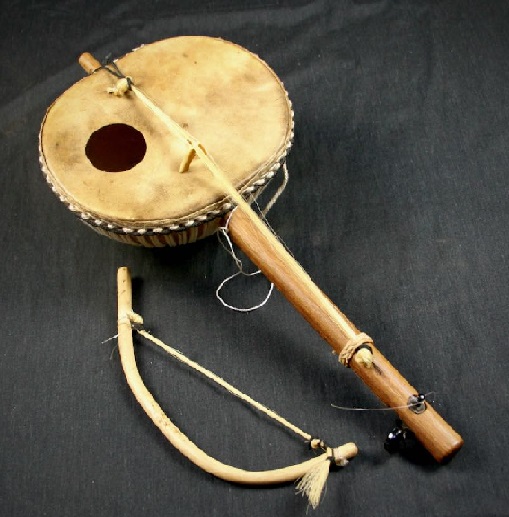Soku
Bowed Instruments
Africa
Between 1001 and 1900 AD
Video
The Soku is a traditional West African fiddle that holds a significant place in the musical heritage of the Wassoulou region, particularly in southwest Mali. Known by various names, including n’diaraka and njarka in Songhai, this ancient instrument is characterized by its unique construction and expressive sound.
The Soku typically features a wooden bridge and a resonating body made from a calabash, which serves as its soundbox. The instrument is strung with a single thread, often composed of multiple smaller fibers, and traditionally uses horsehair for the bow. Measuring approximately 25 cm in width and 50 cm in height, the Soku is relatively small and portable, making it an ideal companion for musicians on the go. The sound produced by the Soku is often described as wailing or soulful, resembling a feminine vocal melody that conveys deep emotion. This quality makes it particularly suitable for storytelling and expressing themes of love, loss, and cultural identity.
History of the Soku
The history of the Soku dates back several centuries, with its origins rooted in West Africa. It is believed to have emerged around the 15th century, although precise dating remains elusive due to the oral nature of African musical traditions. The Soku has been an integral part of the musical landscape in Mali and surrounding regions, playing a crucial role in both social and ceremonial contexts. Traditionally, the Soku was played by griots—musicians and storytellers who served as oral historians within their communities. These musicians would use the Soku to accompany their songs and narratives, preserving cultural stories and histories through music. The instrument’s association with griots highlights its significance as a medium for cultural expression and communication. Over time, the Soku has adapted to various musical styles while maintaining its traditional roots. It has become a staple in Wassoulou music, which is characterized by its rhythmic complexity and lyrical themes that often explore social issues and personal experiences. Despite facing challenges from modernization and globalization, efforts to revive traditional music have contributed to renewed interest in the Soku.
Materials Used in Construction
The construction of the Soku involves several natural materials that contribute to its unique sound quality. The body of the instrument is typically made from a calabash gourd, chosen for its excellent acoustic properties. The wooden bridge supports the string while allowing vibrations to resonate through the gourd. The string itself is traditionally made from horsehair or other natural fibers, providing flexibility and durability. The bow used to play the Soku is also crafted from horsehair, which requires regular maintenance with rosin to ensure optimal sound production. Each component of the Soku is carefully selected to enhance its tonal qualities and overall performance.
How It Works
The Soku produces sound through a combination of bowing techniques and resonance from its calabash body. When the player draws the bow across the string, vibrations are created that travel through the bridge into the gourd. This process amplifies the sound, allowing it to resonate beautifully. Players can control pitch by pressing down on the string with their fingers while adjusting bowing speed and pressure. This technique requires skillful manipulation to achieve different tonal effects, enabling musicians to express a wide range of emotions through their playing.
Types of Soku
While there is primarily one standard type of Soku associated with Wassoulou music, variations may exist based on regional styles or individual craftsmanship. Some musicians may customize their instruments with different materials or modifications to achieve specific tonal qualities. In addition to variations within the Soku itself, related instruments can be found across West Africa. These include other traditional fiddles or stringed instruments that share similarities in construction but differ in playing style or musical context.
Features of the Soku
Key features of the Soku include:
Single String: Provides simplicity while allowing for expressive melodies.
Calabash Resonator: Enhances sound projection and resonance.
Wooden Bridge: Supports string tension while facilitating vibration transfer.
Horsehair Bow: Essential for producing sound through friction.
Cultural Symbolism: Represents heritage and identity among West African communities.
These features collectively contribute to the distinctiveness of the Soku within African music traditions.
Music Composed for the Soku
Music composed for the Soku often reflects traditional themes relevant to West African culture. It serves as an accompaniment for storytelling and singing during social gatherings, celebrations, and rituals. The melodies played on this instrument typically incorporate improvisation and ornamentation, showcasing both tradition and individual creativity.In ensemble settings, the Soku may interact with other instruments such as drums or flutes, creating rich textures that enhance communal experiences during performances. Its ability to convey emotion makes it particularly suited for expressing themes related to love, nature, community life, and social issues.
Cultural Significance
The cultural significance of the Soku extends beyond its musical role; it embodies aspects of identity and heritage among West African communities. As an instrument traditionally associated with griots and storytelling, it represents a connection to cultural narratives passed down through generations. Efforts to preserve traditional music practices have sparked renewed interest in learning how to play instruments like the Soku among younger generations. This revival not only helps maintain cultural traditions but also fosters community cohesion through shared musical experiences.
The Soku is more than just an instrument; it is a vital part of West Africa’s cultural landscape that continues to resonate with audiences today.
FAQ
What is the sound quality of a Soku musical instrument?
The sound of the Soku instrument is rich, resonant, and distinct, often characterized by a deep, mellow tone. It produces a warm and expressive voice with a smooth, sustained quality. The strings vibrate freely, giving the instrument a unique acoustic presence. Its tonal range can vary, from soft whispers to sharp, piercing notes, depending on the technique used by the player.
What type of music is typically played on a Soku instrument?
The Soku is often used in traditional Southeast Asian music, particularly in folk and classical styles. It is commonly featured in ensembles performing ritual, ceremonial, or celebratory music. The instrument's deep tone and expressive range make it ideal for storytelling and emotional expression in music. Its versatility allows it to play both melody and harmony within a musical context.
Who are some famous composers associated with the Soku instrument?
Notable composers associated with the Soku include traditional musicians from Southeast Asia, particularly from Myanmar, Thailand, and Cambodia. These composers often work within the classical and folk traditions, composing pieces that highlight the instrument's unique capabilities. While individual names may not be as internationally recognized, many contribute to preserving regional musical heritage.
 Links
Links
References
Other Instrument
Categories



















